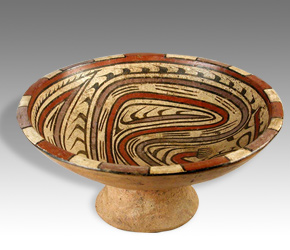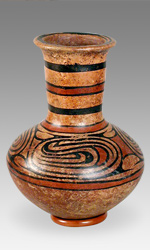Pre-Columbian Coclé Pottery
 |
|
Gran Coclé is an archaeological culture area in pre-Columbian Central America coinciding with the modern-day Panamanian province of Coclé. It consisted of a number of identifiable native cultures, which archaeologists have loosely designated by pottery style. The poorly studied La Mula period ranged from 150 BC to 300 AD. It was followed by the Tonosi period, from 300 AD to 550 AD, and by the Cubita period, from 550 AD to 700 AD.
 |
|
Archaeologists working at intervals since the 1920s have uncovered ruins and burials which contain striking artifacts. These include worked gold and other metals, carved bone, shell, and whale ivory, textiles, jewelry with semi-precious stones, and beautifully painted pottery. Coclé gold work was traded throughout the region, and has been found as far away as Chichen Itza in Yucatán, Mexico. The large collection of Coclé pre-historic pottery is notable for strong structural design and the use of fish, bird, animal and human figures as decoration.
Coclé ceramics constitute some of the highest expressions of art in Pre-Hispanic Central America. Around 800 AD a style known as Macaracas appeared, characterized by bold red, black and purple designs on a cream-white background. Form itself can possess and express symbolic significance, as can design when created for the purpose of a visual language. The ancient Panamanians believed that the vital element of the life force was essentially dualistic, inherent in the male and female aspect. The vessel and bowl above are decorated by three broad bands of color, with the vessel proper surmounted by three highly abstracted avian or bird-like forms. To Panamanians of the period, these beautifully stylized designs would have brought to mind a known mythic or Shamanic being.
Download this Article: Pre-Columbian Coclé Pottery.pdf